CHAPTER ONE: A BASIC THEORY OF PERCEPTION

Before we discuss the components of Perspective and their practical
application, it would serve us to first familiarize ourselves
with the theoretical and abstract foundations upon which it is
built. Only then do we become empowered for life.

It doesn’t matter if we forget the “rules or thumb” or “formulas”—
and chances are we will. However, by understanding perspective
at its root level, anyone (with some diligence and patience)
can easily rebuild his or her basic skill set.
Quite simply, it would be like riding a bicycle.
First and foremost, let us discuss the difference between what we
refer to as “depth perception” and what is commonly known as
“3-D” versus “2-D.” There is a common misconception here:
Using the terms “2-D” and “3-D” to describe the degree to which
an image conveys DEPTH PERCEPTION is misleading because
DEPTH PERCEPTION is a natural phenomenon that can only
occurs when our two eyes (working together) experience the
STEREOSCOPIC effect.
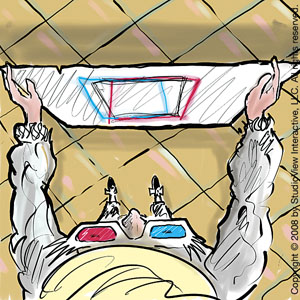
Can two eyes looking at a flat image ever experience the
STEREOSCOPIC effect? Absolutely: Through artificial means, we can
certainly fool the brain into perceiving Depth perception by using
certain optical tools. However, even then, we would still need 2
healty eyes.
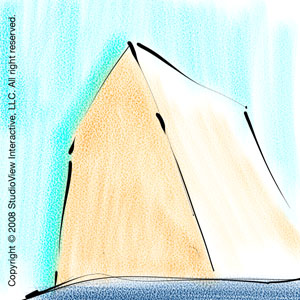
Typically, a flat image depicting three dimensional space (may it
be realistic or abstract in nature) is referred to as a “3-D” image
if produced using computer modeling and rendering versus being
created by hand—otherwise known as “2-D.”
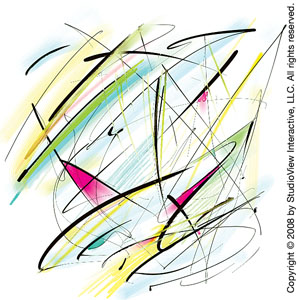
Therefore, the “ 3-D " versus “2-D” label is a categorization
that has to do with the technique of creation versus the inherent
qualities of the image itself. In fact, a “2-D” image (showing a
few pencil strokes even) can convey the notion of 3 dimensional
space as effectively as a “3-D” created using the latest computer
modeling and rendering systems.
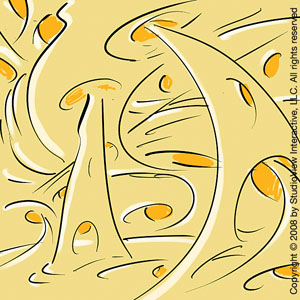
Once again, unless we view the
otherwise flat image through some sort of optical filter, it will
always suffer from a lack of depth perception. Once again, depth
perception is what two healthy eyes, working together, help us
perceive. It is no natural to us, so intuitive, we can’t even explain
what it is. Before I get to “Why any of this is relevant...” let us
conduct a simple experiment:
Please cover one eye and try not to move either your eye or head.
Please try not to blink. Are you beginning to feel the sinking
feeling that the world is becoming eerily flat? Now, open the other
eye. Can you feel the difference?
And with that, we come to our second key point:
Despite the fact we can “read” the three dimensional-aspect of
space with only ONE eye, seeing the world through one human
eye alone can never convey depth perception. Now, why are these
issues important? Because they help us establish the premise
that the field of drawing in Perspective has limitations, and it
often requires that we adjust — even cheat—in order to “fool”
the eye of the observer.
In other words, Perspective as “human” as the humans it taunts!
Ah, but that is no reason to say “then I don’t need to learn the
basics, I’ll just start breaking the rules!”
Good luck and remember that your fellow human beings are so
attuned to foreshortening that just about anyone will be able
to detect your “mistakes.” Ironically, these same human beings
could look at a perspective drawing riddled with technical mistakes,
yet forgive it. The reason why that might happen is outside
the scope of this book. In fact, a lot of has been written about
perspective and we have provided you with a bibliography.
What I can guarantee you is that in order to master the art of
perspective you must get comfortable with its basic science. And
with that, let us proceed to our basic optics theory:
Imagine there is an infinite number of OPTICAL BEAMS projecting
out of your one eye—THE OPTICAL PROJECTOR.
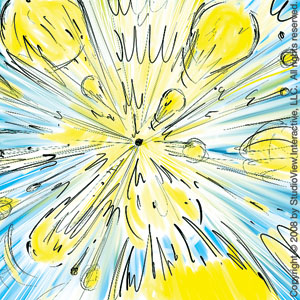
These beams are invisible. They don’t even have any perceptible
thickness. Yet, they are there. Now, imagine that each OPTICAL
BEAM can support PIXELS of light shooting out of your ONE
EYE in all all directions—just like a highway!
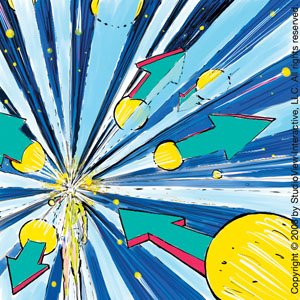
Now, imagine the process is reversed. The eye becomes the
OPTICAL RECEPTOR. Next, please imagine that all your
physical body was able to be compressed into that ONE EYE,
hovering a few feet above the ground. You have become, in essence, a POINT IN SPACE and your nameshall henceforth be “THE OBSERVER.”
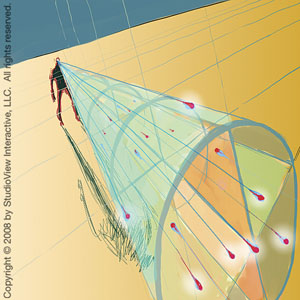
Now, here are your characteristics: You do not move at all when
observing. Once you lock-in on a target, that’s it! You stay absolutely
still. Although you have an infinite number of OPTICAL
BEAMS shooting out of you, your FIELD OF VISION is limited
to 45 degrees—60 degrees even if you rendering won’t look too
distorted, which we will cover later.
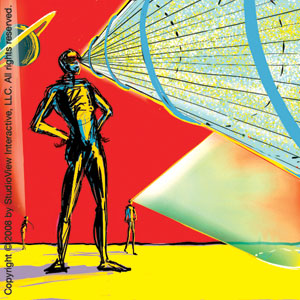
Meanwhile, there are so many OPTICAL BEAMS shooting out
of you that they effectively form a CONE OF VISION. You remember
your basic geometry, right? Points form lines, lines form
surfaces/planes, and surfaces/planes form volumes. For example,
a cone is created when a trianble is rotated around its axis.
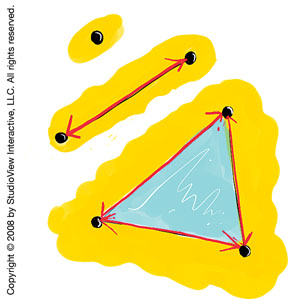
In this case, the CONE OF VISION is a cone of LIGHT... A funnel for
collecting pixels of light... visual information.
Now, what is the FIELD OF VISION relative to the CONE OF
VISION? Simple:
Slice the CONE OF VISION any way you want, provided that
you include the OBSERVER in the slice. Each SLICE will form
a wedge... or an OPTICAL TRIANGLE to be exact. The angle
where the OPTICAL TRIANGLE shoot out of the OBSERVER is
typically 45 to 60 degrees.
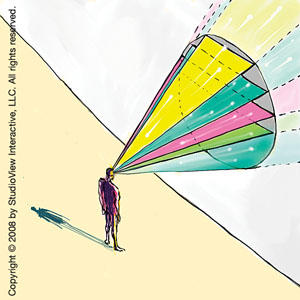
Why? Well, let’s do another experiment:
Remember when I asked you to look ahead with one eye covered?
Great. Please repeat the example. But this time, please try to stay
still long enough...
If you stand still and are able NOT to move your eye, soon enough
you will experience tunnel vision. In other words, objects outside
the 45-60 degree FIELD OF VISION will disappear.
Now, you might present the following argument:
“We have technology and can artificially increase the FIELD OF VISION. Why limit the theoretical FIELD OF VISION—and consequently the angle of the CONE OF VISION—and force it to match a numeric value that matches a real eye?”
In other words, what if we go beyond 60 degrees?
Excellent and valid point!
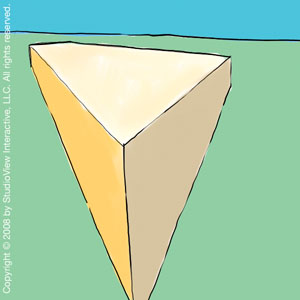
In some case we can. And when we do
break the established values of the angle of the CONE OF VISION,
we would have to improvise ... because the rule of thumbs
rules (which we will learn in the next chapters) will no longer be
valid and the drawing will suffer from too much distortion and
hence become unworkable. Again, that is because the standards
methods of generating perspectives make certain assumptions.
But, as we become comfortable with these rules and assumptions,
we would have demystified the process, and we would begin to
use our experience and intuition.
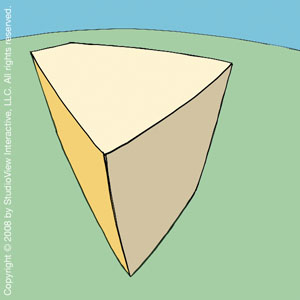
We’ve all seen a fish eye lens effect and the dramatically
distorted—yet believable—foreshortened images in print and on
film. We already —and in addition to what our eyes see on a daily
basis—know what is correct and what isn’t. Add to that the new
and exiting ways we are seeing the world through film, photography,
and illustration etc, here is what you end up with: a good
thing!
Remember looking at an image seen through a fish eye lens?
Even though your own eyes can never naturally see the world in
such an exaggerated fashion, you eventually learned to read these images and later appreciate them as well as relate to them.
Mario Henri Chakkour, AIA
"LIVING SKETCHBOOK™" Copyright © 2008 by StudioView Interactive, LLC.
All rights reserved.
Where's Chapter 2? It's coming soon! Join our mailing list and we'll let you know as soon as it is available!